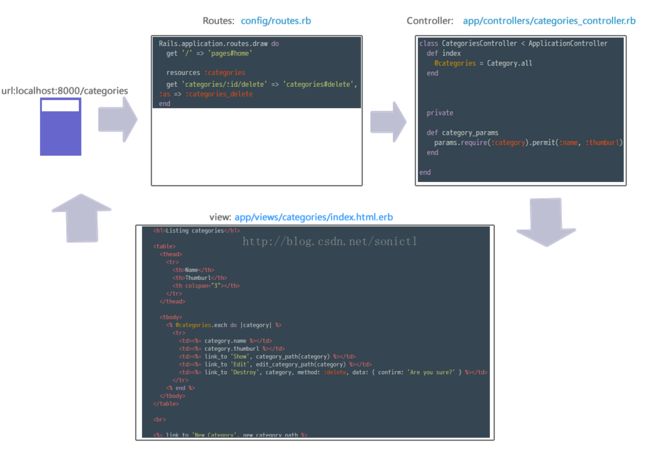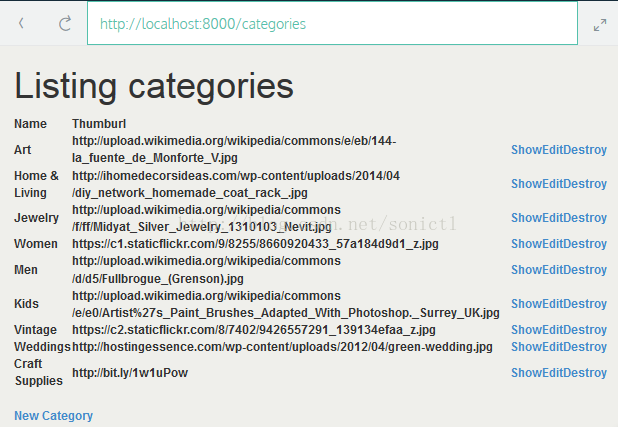Ruby学习笔记4: 动态web app的建立
Ruby学习笔记4: 动态web app的建立
We will first build the Categories page. This page contains topics like Art, Home & Living, and Kids, so our users can browse through categories and find what they like.
Each Category in our site will need to store information about itself, such as a name and an image. Our Category Model is what stores information about our Categories. Remember that our Model manages the data in our app.
===============================
1. Build Model
2. Build Migration Table
3. Add Data to Tables
4. Generate Table Controller
5.
===============================
1. Build our Model
开始之前,我们要先建立Model用来存储每个Category的数据模型。
We can generate a Model with the following rails command:
rails generate model Person
Here Person is an example name for our Model. Model names are always singular.
In your terminal, generate a model named
Category using the rails command. Press Enter.
rails generate model Category
$ rails generate model Category invoke active_record create db/migrate/20141013165110_create_categories.rb create app/models/category.rb invoke test_unit create test/models/category_test.rb create test/fixtures/categories.yml $
2. Build our Migration table
Our Model is fine for now. Let's prepare our Migration table. We do this in two steps:
a. We add columns to our Category Migration table. These will define what information our database can accept.
b. We type bundle exec bundle exec rake db:migrate in our terminal to migrate our database, or update its state.
Let's look at an example. Say we had a Person Model, and we want it to have the columns name and age. In the Migration table, we add columns like this:
def change
create_table :person do |t|
t.string :name
t.integer :age
t.timestamps
end
end
Above we add t.string :name andt.integer :age specifying the name of type string and the age of type integer. We run db:migrate to add a name and age column to our actual database.
Add a name and thumburl attributes to your category migrations. These are both strings. Hit Run.
In your terminal, runbundle exec rake db:migrate to migrate your database. Press Enter.
class CreateCategories < ActiveRecord::Migration
def change
create_table :categories do |t|
t.string :name
t.string :thumburl
#t.timestamps
end
end
end
Terminal:
$ bundle exec rake db:migrate == 20140626211003 CreateCategories: migrating ================================= -- create_table(:categories) -> 0.0010s == 20140626211003 CreateCategories: migrated (0.0010s) ======================== $
3. Add data to Tables
Now that we have columns, we need to add data. This file(in the seeds.rb file) on the below might look intimidating, but it is a simple list of data for our Rails app.
# This file should contain all the record creation needed to seed the database with its default values.
# The data can then be loaded with the rake db:seed (or created alongside the db with db:setup).
#
# Examples:
#
# cities = City.create([{ name: 'Chicago' }, { name: 'Copenhagen' }])
# Mayor.create(name: 'Emanuel', city: cities.first)
art = Category.create(name: 'Art', thumburl: 'http://upload.wikimedia.org/wikipedia/commons/e/eb/144-la_fuente_de_Monforte_V.jpg')
home_and_living = Category.create(name: 'Home & Living', thumburl: 'http://ihomedecorsideas.com/wp-content/uploads/2014/04/diy_network_homemade_coat_rack_.jpg')
jewelry = Category.create(name: 'Jewelry', thumburl: 'http://upload.wikimedia.org/wikipedia/commons/f/ff/Midyat_Silver_Jewelry_1310103_Nevit.jpg')
women = Category.create(name: 'Women', thumburl: 'https://c1.staticflickr.com/9/8255/8660920433_57a184d9d1_z.jpg')
men = Category.create(name: 'Men', thumburl: 'http://upload.wikimedia.org/wikipedia/commons/d/d5/Fullbrogue_(Grenson).jpg')
kids = Category.create(name: 'Kids', thumburl: 'http://upload.wikimedia.org/wikipedia/commons/e/e0/Artist%27s_Paint_Brushes_Adapted_With_Photoshop._Surrey_UK.jpg')
vintage = Category.create(name: 'Vintage', thumburl: 'https://c2.staticflickr.com/8/7402/9426557291_139134efaa_z.jpg')
weddings = Category.create(name: 'Weddings', thumburl: 'http://hostingessence.com/wp-content/uploads/2012/04/green-wedding.jpg')
# Add your category here
How does this work? We store data in two steps.
a. We first add seed data in the seeds.rb file
b. We run rake db:seed in our terminal.
已经加了数据在例子里,这里再练习一下seeding data : Let's look at a small example first.
gia = Person.create(name: 'Gia', age: '8')
Here we create a new object in the Person class with the name Gia and age8. We store this object in a variablegia.
Now let's look at some seed data for Category.
weddings = Category.create(name: 'Weddings', thumburl: 'http://hostingessence.com/wp-content/uploads/2012/04/green-wedding.jpg')
Here, we create a new object in the Category class with the name of Weddings and athumburl. We store this in the variable weddings.
=========== Instructions ===========
Look in your seeds file, seeds.rb. On line 17, add seed data for craft_supplies. The entry should have a name'Craft Supplies' and a thumburl of'http://bit.ly/1w1uPow'. Store this entry in a variable called craft_supplies. Hit Run.
In your terminal, run rake db:seed [更正:bundle exec rake db:seed ] to add the data from seeds into your database. Press Enter.
# Add your category here: craft_supplies = Category.create(name:'Craft Supplies',thumburl:'http://bit.ly/1w1uPow')in Terminal, type this command and hit Enter:
$ rake db:seed rake aborted! Gem::LoadError: You have already activated rake 10.4.2, but your Gemfile requires rake 10.3.2. Prepending `bundle exec` to your command may solve this. /var/lib/gems/2.0.0/gems/bundler-1.7.3/lib/bundler/runtime.rb:34:in `block in setup' /var/lib/gems/2.0.0/gems/bundler-1.7.3/lib/bundler/runtime.rb:19:in `setup' /var/lib/gems/2.0.0/gems/bundler-1.7.3/lib/bundler.rb:121:in `setup' /var/lib/gems/2.0.0/gems/bundler-1.7.3/lib/bundler/setup.rb:17:in `<top (required)>' /home/ccuser/workspace/ecommerce-rails-app/config/boot.rb:4:in `<top (required)>' /home/ccuser/workspace/ecommerce-rails-app/config/application.rb:1:in `<top (required)>' /home/ccuser/workspace/ecommerce-rails-app/Rakefile:4:in `<top (required)>' (See full trace by running task with --trace) $我们得到一个错误:rake aborted! 看它的说明,使用这个命令即可:
$ bundle exec rake db:seed
OK.
4.Generate table Controller
建立了数据库操作的基本东东,但目前我们table里的数据是static的,所以我们又要建立Controller,让我们来改变页面里的内容。
但目前我们table里的数据是static的,所以我们又要建立Controller,让我们来改变页面里的内容。In Rails,数据库操作的五个主要的方式methods: index, show, new, edit, delete. 这几个在动态Rails App里是一样的,对以后的学习有帮助。
还记得我们建立Persons Controller时候用的命令吗?
>> rails genertate controller Persons
所以我们就可以在命令行里添加methods,同时,Rails会updates相关的routes和Views for us.
例如,如果我们想要添加 index ,new, edit 这三个mothods到Persons这个Controller,使用如下的命令:
>> rails generate controller Persons index new edit
注:一般Controller的名字是plural复数,Model的名字是单数。
【好,这里的操作】1.In your terminal, generate a controller Categories with the main methods we’ll use: index, show, new, edit, and delete. Press Enter.
>> rails generate controller Categories index show new edit delete
$ rails generate controller Categories index show new edit delete create app/controllers/categories_controller.rb route get 'categories/delete' route get 'categories/edit' route get 'categories/new' route get 'categories/show' route get 'categories/index' invoke erb create app/views/categories create app/views/categories/index.html.erb create app/views/categories/show.html.erb create app/views/categories/new.html.erb create app/views/categories/edit.html.erb create app/views/categories/delete.html.erb invoke test_unit create test/controllers/categories_controller_test.rb invoke helper create app/helpers/categories_helper.rb invoke test_unit create test/helpers/categories_helper_test.rb invoke assets invoke coffee create app/assets/javascripts/categories.js.coffee invoke scss create app/assets/stylesheets/categories.css.scss $
done!这样我们就又建立了一个Controller,里面有操作数据库的5个methods,如下:
catogories_controller.rb文件:
class CategoriesController < ApplicationController def index end def show end def new end def edit end def delete end end然后我们就要来写这些methods里的具体的语句。
---<1>---关于安全
但是,开始之前,我们要保证从model来的数据的安全,所以:
There's one step we do before writing our main Controller methods: we need our Controller to have a secure way of getting information from our Model.
We'll use a private method to do this called strong parameters. This method prevents a user from hacking into our app and changing our Model.
要让method ”strong parameters“ 变得private从而阻止黑客入侵。首先前面有个private, 然后加上这个strong params method, 这个会store all our infor 并且只让开发者访问下面的method.e.g.:
private def person_params params.require(:person).permit(:name, :age) end这里我们是以persons Controller为例,we make a private person_params method. In the body of the method, we require the Model name (person), and permit the columns (name, age).现在任何时候我们想要person的信息,我们都引用为我们存储了信息的person_params method.
【好,这里的操作】In categories_controller.rb, beneath the end afterdef delete, declare aprivate method. Under the private, create acategory_params method for categories. Remember to requirecategory and permit aname and thumburl. Useend to close it. Hit Run.
class CategoriesController < ApplicationController def index end def show end def new end def edit end def delete end #declare a private method private def category_params params.require(:category).permit(:name, :thumburl) end end上面用到了params.require,是一个验证method, 大意是只有name 和 thumburl可以被验证通过,存入model,详见:http://stackoverflow.com/questions/18424671/what-is-params-requireperson-permitname-age-doing-in-rails-4
---<2>---加入methods内容
我们来丰富Controller的methods内容:**First, the index method. The index method takes every entry in our database and stores it as a variable.
If each record in our app is about person, the index method would show us all persons in our database. Just like a real index. It looks like this:
def index
@persons = Person.all
end
Here we take all persons, and store them in an instance variable @persons.
【操作】
在categories_controller.rb文件中:
def index @categories = Category.all end开始丰富下一个method之前,我们先来试一下index工作没有。
===== 接下来就不知所云 =====
在Rails App的Request-Response Cycle里,我们已知一个url请求来了要经过route分发到正确的Controller & View. 对于五个数据库操作的methods,我们都要有route and view 与之对应。
Recall how we said Rails does some magic for us. It actually does two pieces of magic when we generate a Controller with methods!
a. It updates the routes file routes.rb with resources :categories. This shorthand will take care of our routes for the methods we will implement in Categories Controller.
b. It creates index.html.erb in the Views folder
When we generate a Controller with a given methods, it creates a route and View for us, magically. Otherwise, we have to do this manually.
【Instructions】
Check out routes.rb to see resources :categories. Then, in the browser window, visit localhost:8000/categories to see the index view Rails created.
**在 config/routes.rb文件中,
Rails.application.routes.draw do get '/' => 'pages#home' #这样写总算是让人有点明白了 resources :categories #这是一种方法,还有以下两种方法: #get '/categories' => 'categories#index' #get 'categories/index' #browser_url: http://localhost:8000/categories/index get 'categories/:id/delete' => 'categories#delete', :as => :categories_delete end
**在index.html.erb文件中:
<h1>Categories#index</h1> <p>Find me in app/views/categories/index.html.erb</p>
Rails建立了一个route and View for us, 但是是个空的文件,改变index.html.erb文件,让它看起来好点。index视图应该怎么样的?index method保存了数据库的所有条目,所以index 视图应该显示出所有条目。看个例子:
Say we have a persons index page want to show all persons in our collection.
We write:
--------------
<% @persons.each do |person| %>
<tr>
<td><%= person.name %></td>
<td><%= person.age %></td>
</tr>
<% end %>
--------------
Here we go through each person stored in @persons with an iterator and print out the attributes person.name and person.age.
然后把这个应用在index.html.erb的cagegory组里:
**index.html.erb文件:
<h1>Listing categories</h1>
<table>
<thead>
<tr>
<th>Name</th>
<th>Thumburl</th>
<th colspan="3"></th>
</tr>
</thead>
<tbody>
<% @categories.each do |category| %>
<tr>
<td><%= category.name %></td>
<td><%= category.thumburl %></td>
<td><%= link_to 'Show', category_path(category) %></td>
<td><%= link_to 'Edit', edit_category_path(category) %></td>
<td><%= link_to 'Destroy', category, method: :delete, data: { confirm: 'Are you sure?' } %></td>
</tr>
<% end %>
</tbody>
</table>
<br>
<%= link_to 'New Category', new_category_path %>
此时再来访问localhost:8000/categories即可获得列表:
The index page we made has all the right information, but it didn't have the structure and style. We've added the supporting HTML code for the view.
文件和信息流程图如下,
但有几个疑问:
1. config/routes.rb文件中get 'categories/:id/delete' => 'categories#delete', :as => :categories_delete不能动,为啥?
2. routes.rb 与 Controller是怎么联系的?或者routes.rb, controller, view 三者是怎么联系?
3. index.html.erb文件中,
以下是加入了style效果的html:
<%= render 'shared/topnav' %>
<div class="categories">
<div class="container">
<div class="row">
<div class="col-md-2">
<h2>Categories</h2>
<p>Explore our latest categories from around the world.</p>
</div>
<div class="col-md-8">
<% @categories.in_groups_of(3).each do |categories| %>
<% categories.select! {|x| !x.nil?} %>
<div class='row'>
<% categories.each do |category| %>
<div class='col-md-4'>
<div class="thumbnail">
<img src= <%= category.thumburl %> >
<div class="caption">
<span class="listing-title"><%= category.name %></span>
<span><%= link_to "Edit", edit_category_path(category.id) %></span>
<span><%= link_to 'Show', category %></span>
<td><%= link_to 'Delete', categories_delete_path(:id => category.id) %></td>
</div>
</div>
</div>
<% end %>
</div>
<% end %>
</div>
</div>
</div>
</div>
<table>
<thead>
<tr>
<th>Category name</th>
<th colspan="3"></th>
</tr>
</thead>
<tbody>
<% @categories.each do |category| %>
<tr>
<td><%= category.name %></td>
<div class="thumbnail">
<img src= <%=category.thumburl %> >
<div>
<td><%= link_to 'Show', category %></td>
<td><%= link_to 'Edit', edit_category_path(category) %></td>
<td><%= link_to 'Delete', categories_delete_path(:id => category.id) %></td>
</tr>
<% end %>
</tbody>
</table>
<br>
<%= link_to 'New Category', new_category_path %>
<%= render 'shared/footer' %>
验证了。没搞懂。
** app/controllers/categories_controller.rb文件:
class CategoriesController < ApplicationController
def index
@categories = Category.all
end
def show
end
def new
end
def edit
end
def delete
end
private
def category_params
params.require(:category).permit(:name, :thumburl)
end
end
================
继续丰富我们的controller:
While index gave all categories, show allows us to access one category. This this is helpful when we want to show just one Category at a time in our Etsy app.
The show method works like this. we write:
def show @category = Category.find(params[:id]) end
5.
